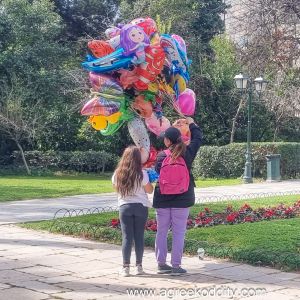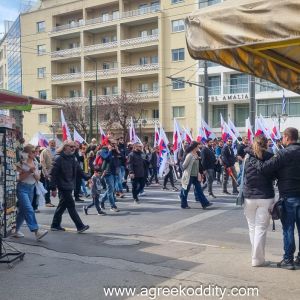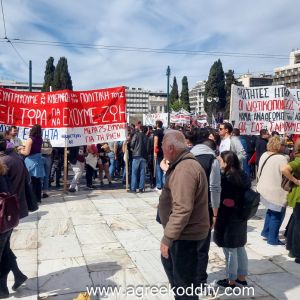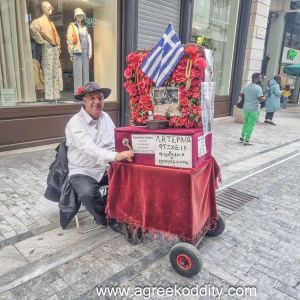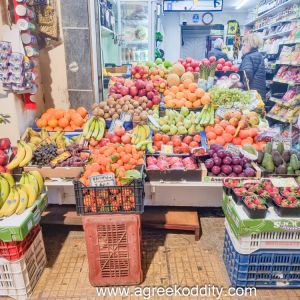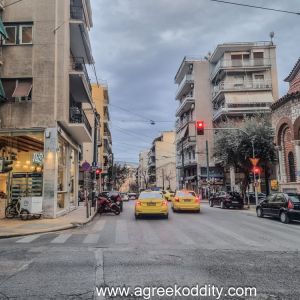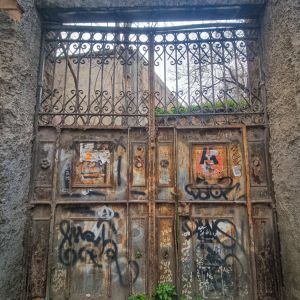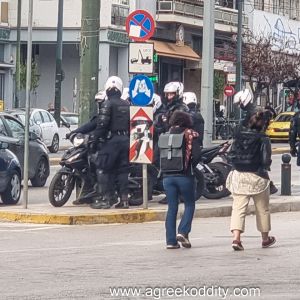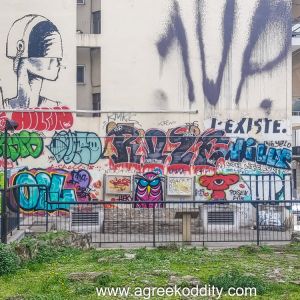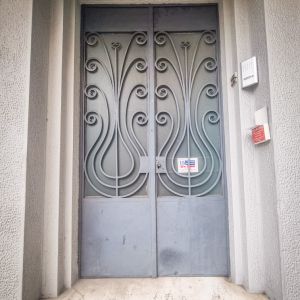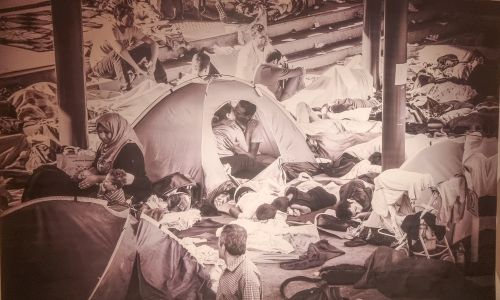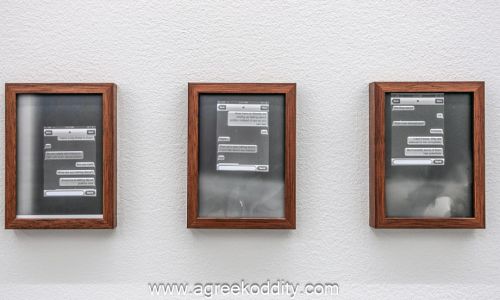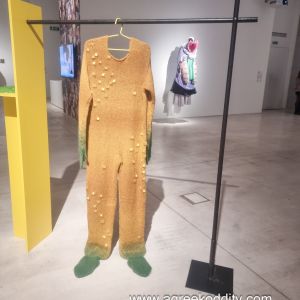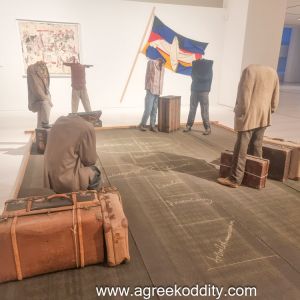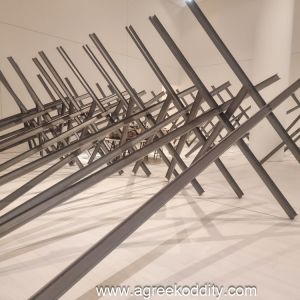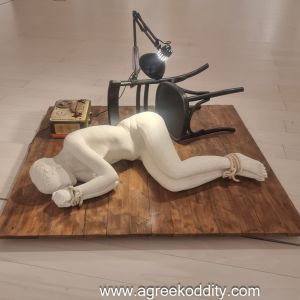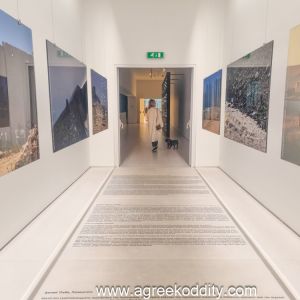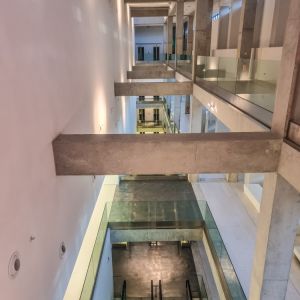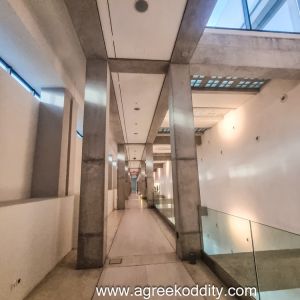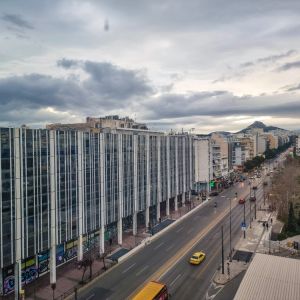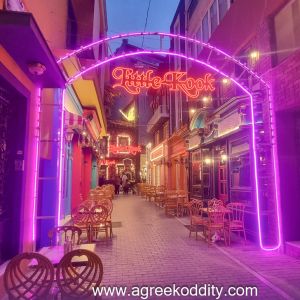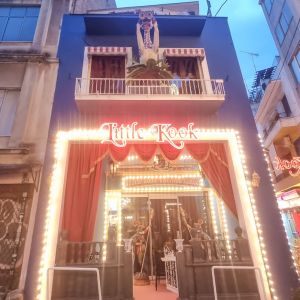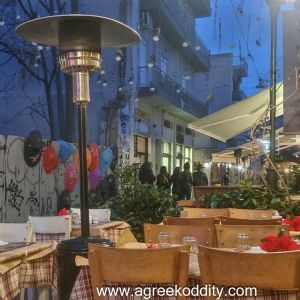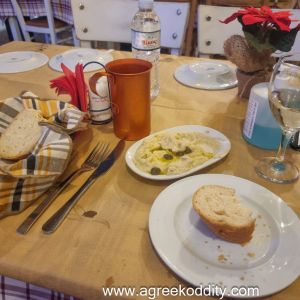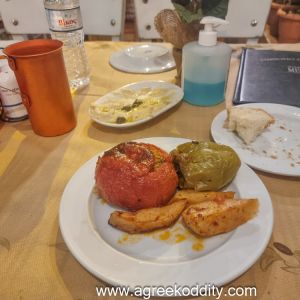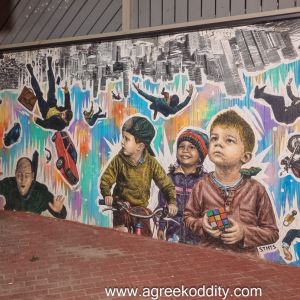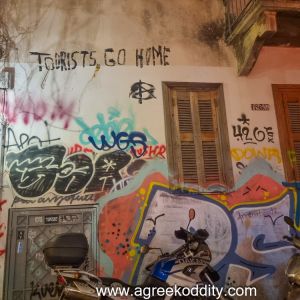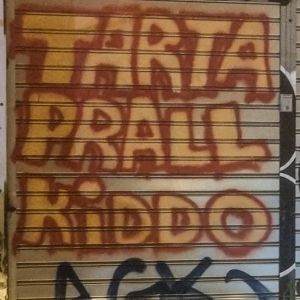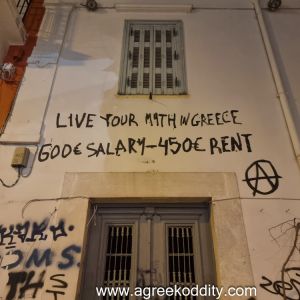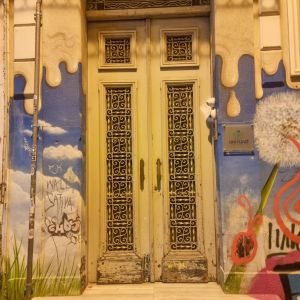Athens Day 2 Continued- Protests, Culture and a bit of Psiri
After cooling myself off in the shade of the National Gardens (Evzones have that effect on me!), the next phase of my Athens explorations commence. As I walk through the gardens absorbing the calm and tranquillity, I can hear the sounds of chanting. I know already that a protest march is scheduled for today so I’m not surprised when I see a parade of people marching towards Syntagma Square. A parade of people is an understatement as Syntagma Square is heaving with bodies.
Athens has seen many demonstrations taking place recently, especially in relation to the terrible train crash that had taken place just over a week ago. I had expected this to be something similar but after watching and observing I can sense that although there is determination in the demonstrators, there isn’t the raw grief and anger being displayed that I’d seen on the news. This seems resolute but calm. The demonstrations seem to be about “crushing the government” and something relating to students – according to Google Translate that is. I am by instinct a curious person but know when to draw the line before it begins to feel like voyeurism and head off to my next destination. Walking down Ermou I see Mr Taraposos with his Barrel Organ – a permanent fixture here and part of the fabric of Old Athens.
This afternoon I am going to visit the National Museum of Contemporary Art (NMCA) located in the traditional neighbourhood of Koukaki. The arts centre is just off the busy highway of Andrea Syngrou Avenue with the nearest metro station being Syngrou Fix. However, I’m not going to catch the metro, but make my way there on foot just so that I can absorb some of the atmosphere of the neighbourhood.
The NMCA is housed in the former Fix brewery hence the reference to it in the location. Google Maps guides me through Plaka and past the Acropolis Museum and then out and away from the main tourist areas. I love the neighbourhoods in Athens. I have a mission to explore as many of them as I can during each visit to Athens. No mean feat, especially when one locality flows into another.
As I reach the busy highway of Andrea Syngrou Avenue I notice clusters of leather-clad police on motorbikes, waiting in what looks like strategic positions around the city. Something is afoot but I don’t know what.
I cross the busy 6-lane highway and after another few minutes find myself at the entrance to the NMCA. Once inside there is a beautiful bright concourse with an information desk, a ticket desk, a small cafe and various seating areas. After purchasing my ticket I take the escalators down to the basement level where there are lockers to leave my coat and bag. This is great as this building is huge and a lot of walking is going to be required. Also down in the basement is the temporary exhibition space where an exhibition entitled Modern Love (or Love in the Age of cold intimacies) is located, so I start here.
Firstly, here is a bit of blurb about Modern love from the NMCA’s website:
Modern Love (or Love in the Age of Cold Intimacies) is the next major group exhibition at NMCA (EMST). Curated by artistic director Katerina Gregos, it launches the museum’s winter-spring exhibition cycle, which focuses on digital technology and its influence on intimate human relationships. The subtitle of the exhibition is a reference to Eva Illouz’s book, Cold Intimacies: The Making of Emotional Capitalism, which argues that these relationships have become increasingly defined by economic and political models of bargaining, exchange, and equity. The exhibition explores the state of love and human bonds in the age of the Internet, social media, and high capitalism, probing how the digital sphere, the impact of technology giants, and neo-liberal practices have transformed love, social relations, and the way we interact with one another. The accessibility of the Internet to an ever-greater number of people has had liberating effects, encouraging and empowering more open and diverse lifestyles, contributing to the dissolution of interpersonal orthodox conventions and social constrictions, and crumbling taboos and biases around gender and sexuality. The exhibition investigates the pathologies and problems afflicting love and matters of the heart and attempts to imagine a way out of our current alienation, emotional sterility, and loneliness.
I love modern art and in particular, I like to try and work out the thought processes of the creator. This exhibition which runs until the 5th of November 2023, has some very eclectic pieces. Some that really resonate with me and of course – others that don’t.
Sitting in the heart of the exhibition is an emotive piece of photography that captures a moment of tenderness between two people in a refugee camp. So taken with was I, that I didn’t take a note of the artist. No words needed.
Another one that took my interest was a piece by artist Mahmoud Khaled – a series of framed snapshots from a conversation between two Egyptian men on social networking app, Grindr. As the chat progresses, they realise that although they don’t know each other, they have noticed each other on the street in passing. They were unaware of the sexuality of the other person until they started speaking on Grindr, and of course, they would never make any interest in each other known in public. Such is the conservative society of Egypt.
Also in this exhibition are two pieces that, although I can see how they have been crafted and/or constructed, the thought process behind them escapes me. But that is fine and is what also brings some excitement and interest in viewing other people’s work. The first is a yellow knitted suit adorned with plastic squares and what looks like hand-dyed hands and feet. The other piece by artist Duran Lantink entitled Look 3 Purple Vagina Face makes me smile.
I make my way up through the various floors of exhibits. One thing is for sure, the architecture of this building is magnificent and a perfect setting for the various exhibitions. On one floor (I forget which) large plate glass windows offer panoramic views over Athens. Just to give some context to the location, straight ahead is Mount Lycabettus and then looking out to the left is the Acropolis and Philipappos Hill and monument.
I become so engrossed in the exhibitions that I lose track of time. It is time to move on and head back to the hotel.
Later that evening I decided to stay local to the hotel and eat in Psiri which sits behind the Attalos and is definitely one of the coolest places in the city. If you haven’t been here before, don’t be put off by the graffiti (I prefer the term ‘street art’ and the edgy feel of the place – cool places aren’t just for young ones right? By day Psiri is where you will find artisanal shops and everyday businesses but by night it transforms into a lively and buzzing hive of taverna’s and cool bars. Have I used the word cool one too many times? Probably.
Psiri wasn’t always like this. It was once a residential area for people who had moved from the country to the city for work. During the late 19th century several gangs of ‘wrong uns’ made Psiri their base for their nefarious activities. By day they worked as grave diggers (a job in much demand due to the cholera epidemic). They would also be hired by politicians to cheer for them during their campaign speeches but also to be used as protection. Such was the interwoven nature of the relationship between the politicians and the criminal fraternity, that no real effort was made to bring them to task.
Dimitris Koutsavakis from Piraeus was one such gang leader who became known for his iconic style. Their ‘uniform’ was made up of black and white striped trousers, pointed shoes which I imagine to look like latter-day winkle pickers, and a black jacket with only one arm through a sleeve. The jacket just rested on the shoulder of the other arm in preparation for throwing it off in readiness for a fight. Around the waist was a wide belt sporting a whole array of weapons. One of the tricks employed by the gang members was to leave their belts trailing on the ground. If anyone accidentally stood on it, that would be a good enough reason to start a fight and more often than not – this was a fatal mistake. It wasn’t just their clothing that indicated gang membership but it was also in the way that they wore their hair. It was ‘de rigeur’ to wear their hair long and slicked back with oil. Their faces were also adorned with long moustaches also oiled to within inches of their lives. The whole look was finished off with a set of large Kolomboi beads which I imagine could be used in a menacing rather than a contemplative way!
Their cruel and violent profiteering and the grip that they had over the establishment remained strong until the waning years of the late 19th century. When the canny Police Chief, Dimitrios Bairaktaris took office he employed a series of tactics to drive the gangs out – no mean feat!
Psiri began to flourish again and once more became a place to live and work. This began to decline again around the 1980’s and the area became run down and had a reputation for being unsafe. However, help was at hand when the 2004 Olympics were held in Greece. Investment in the area was the beginning of its renaissance where it became a place to not only live and work, but it established itself as a huge part of the city’s nighttime economy.
And this is where I find myself now. There are several ways that you can get into Psiri for example by taking a side street on Athinas Street just a little further down from the Attalos Hotel. You can also access it by heading down Ermou with Monastiraki Square on your left and then taking a right. This evening I take the latter option and turn right off Ermou at the Lotus Inn, and this is because I love to walk past Little Kook and admire in wonderment their festive adornments. Yes it’s a little (a lot) bit tacky and a wee bit Disneyfied but it’s fun and it makes me smile!
So enchanted am I by Little Kook that I almost forget that I’m starving. I just plonk for the nearest taverna which is Simposio Sto Psiri. It’s a traditional taverna with good hearty Greek fare and I do love anywhere with a checked tablecloth! I choose Skordalia to start and Gemista for my main meal washed down with white wine. What more can a ravenous, old traveller ask for?
I spend the rest of the evening taking a slow amble around Psiri admiring the street art and taking any random street that takes my fancy. I do find myself down some deserted back alleys and this doesn’t bother me. I’ve felt more under threat in some of Athen’s main tourist spots. I’ve never felt the urge to go back to Anafiotika since I was pickpocketed just over a year ago. This group of one woman and two teenage boys followed me everywhere and I knew I had to get away from them. As I moved to go down a set of steps they too came after me. The last thing I needed was yo find myself in a hidden narrow staircase with them. I had to wait until a lady with her children to walk by and I walked with her to safety. However, they had already been in my bag but thankfully hadn’t taken anything apart from some medication and a packet of masks. My purse was well away from their thieving hands. Anyway, I’ve written about this experience already and I don’t want to think about it right now.
Let’s end the day on a gallery of Psiri street art. A question. Can anyone tell what the graffiti Tarta Prall Kiddo is in reference to? Is it the tag for a graffiti artist? I’ve seen this in various locations during this trip including in the mountain village of Kalavryta and Google ain’t helping me any! Anyway 21,587 steps today. Athens does that to me!


